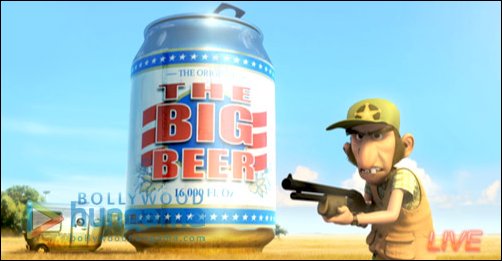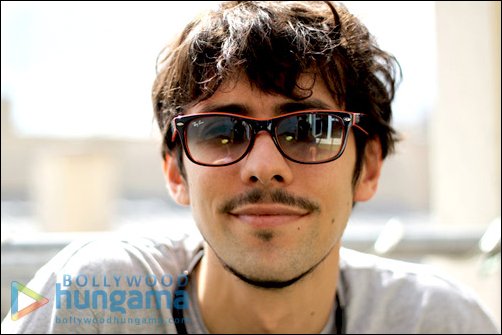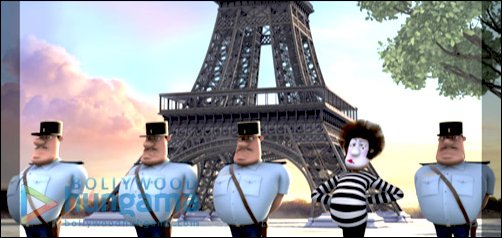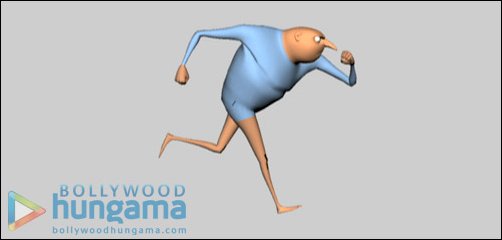People Behind the Scenes: Interview with Despicable Me animator Maxime Maleo
-
 How do you go about starting the animation process when you begin a scene? To begin with, Read More">I spend the entire day drawing various sketches and ideas that I can imagine; this makes me more familiar to the character and the situation. With this I find the model type and the main poses of theRead More
How do you go about starting the animation process when you begin a scene? To begin with, Read More">I spend the entire day drawing various sketches and ideas that I can imagine; this makes me more familiar to the character and the situation. With this I find the model type and the main poses of theRead MoreHow do you go about starting the animation process when you begin a scene?
To begin with, I spend the entire day drawing various sketches and ideas that I can imagine; this makes me more familiar to the character and the situation. With this I find the model type and the main poses of the character. In addition to this, I find the tempo and rhythm of the animation. You start questioning the character the more you draw. When I'm satisfied with my sketches, I'd get feedback from the director on improvising.
I think we should always follow a process, with this at the end you have something fine and very detailed. When I'm clear of all doubts regarding direction, I start blocking the main poses of the character in the shot. I always emphasize on strong poses whether if it's in 2D or 3D. When the blocking phase completes, I work on the breakdowns of those main poses. Then I polish all the in-betweens that I made only after I've added antics and the other ingredients of the animation. These methods can be applied to any kind of film and shot. But the most important thing is to draw since it enhances the thinking process of the artist. Animation is not spontaneous; it's about thinking first and then applying what you think about.
Where do you see the global animation industry going? What do you feel about the fate of the Indian and French animation industry?
We've been doing animation for many years and till today it still seems limitless, I think we're just starting the story of animation. With all the mythological content available, India has a great future in the industry. Animation is an intimate process; I still feel like a beginner. I remember one of my teachers in Les Gobelins told me that the best thing to do to stay on track is to keep learning all the time. With any new shot I feel like a rookie, because you'll always have a shot that you don't know how to do. That's why I love this job. -
 How do you think an animator should evolve? Animation is like a global hub, you have to watch dancing, observe paintings; you need to go to the theatres, Read More">you need to feel music because music is timing. One needs to be involved in a little bit of everything. I think an animator should evolve byRead More
How do you think an animator should evolve? Animation is like a global hub, you have to watch dancing, observe paintings; you need to go to the theatres, Read More">you need to feel music because music is timing. One needs to be involved in a little bit of everything. I think an animator should evolve byRead MoreHow do you think an animator should evolve?
Animation is like a global hub, you have to watch dancing, observe paintings; you need to go to the theatres, you need to feel music because music is timing. One needs to be involved in a little bit of everything. I think an animator should evolve by observing and watching not only movies but life itself. You will give back what you learn by watching. I've dabbled in music for many years, when I'm not animating, I do music, and when I go back to my animation I get a sense of rhythm of the beats that make the tempo of my shot and animation is all about tempo. You could make good strong poses but without good timing the animation fails to deliver.
With stiff competition and hidden talent strewn everywhere across the world and here in India, how do you think one should find his way into the industry?
Aspirants should always be curious, be informed. I watch one movie everyday religiously. This enhances my vision which helps troubleshooting difficult shots and I'm always curious about how things work in this world.
And to conclude this, in a sentence animation to you is...
Since, I've always been doing and dreaming of it, animation is the dream of my life. -
 How many scenes have you animated, and how long did it take to complete? In over a year, Read More">I’ve worked on about twenty five shots which are quite a few. The weekly quota of animation that each animator had to produce was four seconds by studio law. This was one of the best production-pipelines thatRead More
How many scenes have you animated, and how long did it take to complete? In over a year, Read More">I’ve worked on about twenty five shots which are quite a few. The weekly quota of animation that each animator had to produce was four seconds by studio law. This was one of the best production-pipelines thatRead MoreHow many scenes have you animated, and how long did it take to complete?
In over a year, I've worked on about twenty five shots which are quite a few. The weekly quota of animation that each animator had to produce was four seconds by studio law. This was one of the best production-pipelines that we had in France. It took two years to make the film, but if you take pre-production and pre-visualization into account, it would add up to more than three years. The animation phase of the film itself lasted for a year and three months. With the success of Despicable Me, the studio in France is getting a lot more projects, and we're basically outsourcing from the Americans. Long before, Walt Disney studios outsourced work in Paris and now, people from Illumination believe that France is capable of churning out good films. This has happened for the first time in ten years to the French animation industry.
Are you comfortable working with Manga, Disney or any other animation style? What do you prefer?
To be honest a good animator should be able to animate any kind of style put forth and if you really like animation, then the style shouldn't matter. If I get a project that calls for Manga style, I'll work with it. I've been studying Japanese animation and I love it, I like the American style as well. I would say I prefer Manga by watching, but by doing I like both the styles. Since I know both ways of working, I can make my animation smarter sometimes by adding a little bit of one with a little bit of the other. It's like cooking food; you mix in the ingredients to make it good, the fusion of both styles would be my favorite style.
The longer I work in the industry the more I start to treat both 2D and 3D in the same light, because it's only the flat picture in the end that counts. Whether its stereoscopy or not, animation will remain the same. We need to think of it this way. A good movie to me should balance the shot, the intensity of the shot and the style should always serve the story that's the most important thing as an animator. For my projects and short films I try to apply this fusion which makes the piece richer. -
 What was the animation process like for Despicable Me? The film is produced by Chris Meledandri of Ice Age fame, who quit Blue Sky Studios to build a new faction with Universal Pictures called Illumination Entertainment. The animation pipeline was a lot like the American process, Read More">the methods of working was in par with DreamWorks.Read More
What was the animation process like for Despicable Me? The film is produced by Chris Meledandri of Ice Age fame, who quit Blue Sky Studios to build a new faction with Universal Pictures called Illumination Entertainment. The animation pipeline was a lot like the American process, Read More">the methods of working was in par with DreamWorks.Read MoreWhat was the animation process like for Despicable Me?
The film is produced by Chris Meledandri of Ice Age fame, who quit Blue Sky Studios to build a new faction with Universal Pictures called Illumination Entertainment. The animation pipeline was a lot like the American process, the methods of working was in par with DreamWorks. The director of the film was amazing, first the extreme poses of the character animation is blocked out, then it undergoes the first and second phase, the polish phase and it concludes with the final phase of the animation. This gave us an organized, good condition of working. Despicable Me released in July and received a lot of good reviews in America. The film released in France in the beginning of October. -
 How did you find yourself as Animation Supervisor for Marathon’s MBC? Was it luck? A friend of mine overheard a conversation of a director at Marathon Productions, who needed an animator, Read More">so he spoke to the director about me and said that I would fit the bill. Usually the French don’t go out of theirRead More
How did you find yourself as Animation Supervisor for Marathon’s MBC? Was it luck? A friend of mine overheard a conversation of a director at Marathon Productions, who needed an animator, Read More">so he spoke to the director about me and said that I would fit the bill. Usually the French don’t go out of theirRead MoreHow did you find yourself as Animation Supervisor for Marathon's MBC? Was it luck?
A friend of mine overheard a conversation of a director at Marathon Productions, who needed an animator, so he spoke to the director about me and said that I would fit the bill. Usually the French don't go out of their boundaries to find work, and the job required the artist, to expatriate himself to India for a few months to supervise animation for MBC in Mumbai.
At this time, I just finished my short film Burning Safari. I was at my parents place when somehow, that director rang and asked me if I wanted the job. I didn't think twice, I said yes and hopped on the bus. Two weeks later I started preparing for the animation and two months thereafter I was in Mumbai. When I look back, I think it was luck because, I didn't apply for the job it just happened for me. This was my first gig in the animation industry.
What else have you dabbled in after your stint at Marathon?
After supervising MBC, I got hired by DreamWorks at San Diego where I interned for a few months. Right after my internship, I started working on Madagascar Escape 2 Africa as an animator. After my stint at DreamWorks I went back to Marathon production where I supervised animation again. When my time was through with Marathon, I went back to France and joined Mac Guff, an award winning studio situated in Paris. In 2009, was a start to an amazing adventure when I bagged Despicable Me as an animator. I met a lot of great animators who worked on the film they taught me a lot of tricks of the trade. I mostly animated Gru and a little bit of the girls as well. Early 2010, I started work on pre-production for my short film that I'm directing. The film is being produced by Kawa Animation a studio in Paris. Currently, I'm hired as a director for an undisclosed TV show from Marathon Productions again.




